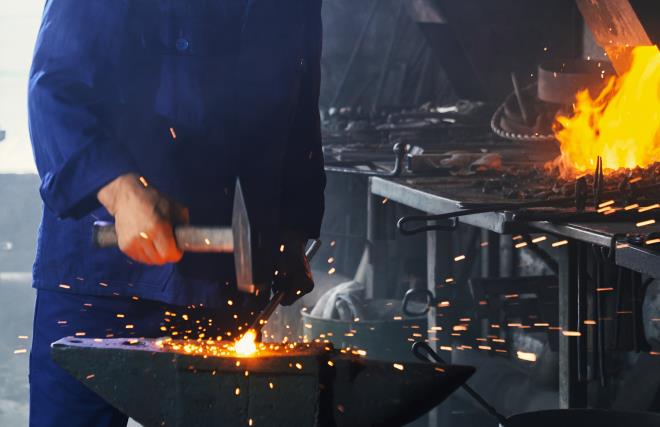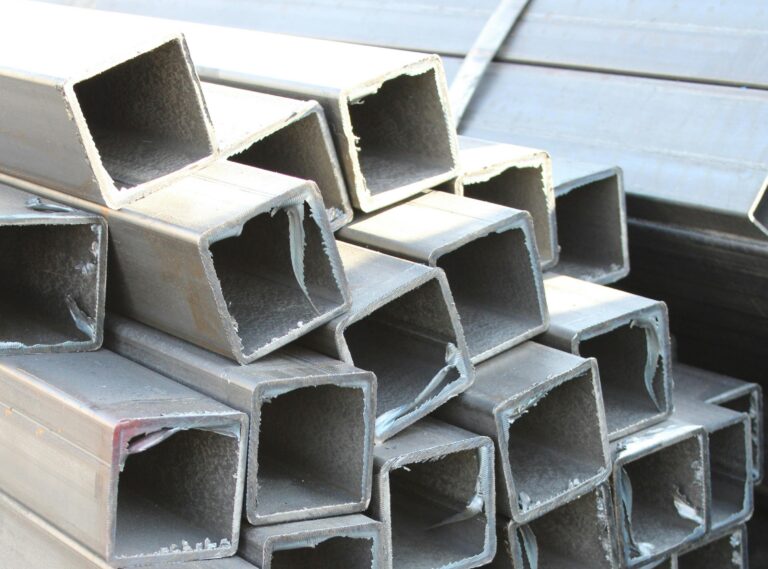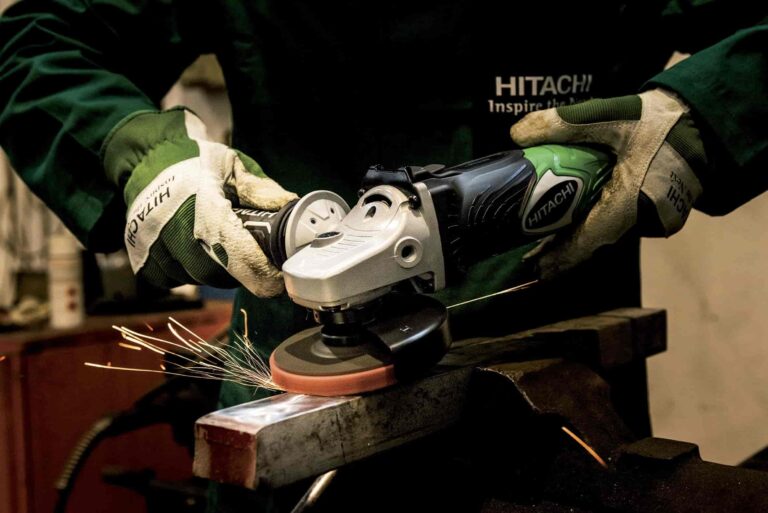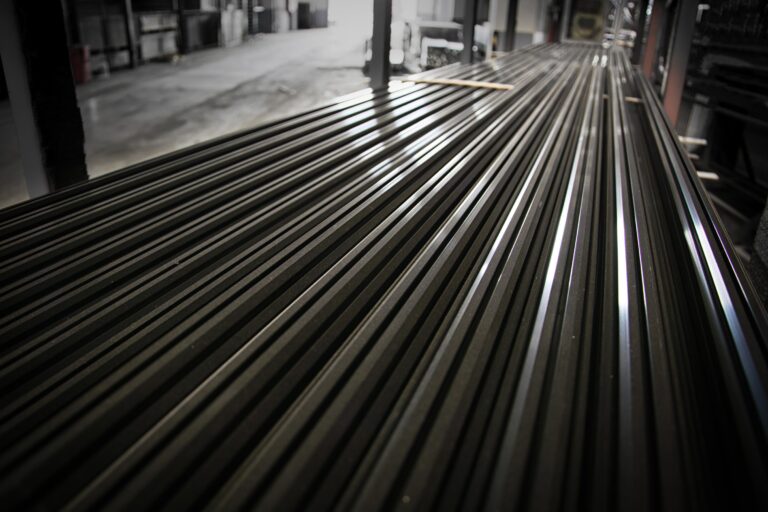The steel choice for kitchen knives is crucial. It determines the entire characteristics of the blade your customers will get from the purchase. However, knife steel is the first topic knife shops just getting launched find themselves lost.
The number of knife steels used for kitchen knives, metallurgy behind them, heat treatment, and all the other small details can overwhelm even knife enthusiasts. While it can get complicated quickly, it doesn’t have to be.
This article is here to help you choose the best steel for kitchen knives in this article. We’ll cover the types of kitchen knife steel, review the popular picks in a simple manner, and help you choose.
Bookmark this page to check the traits of various knife steel when choosing a product to outsource.
Types of kitchen knife steel
Before we dive right into the steel names and their features, let’s go over the different types of steel for an easier understanding.
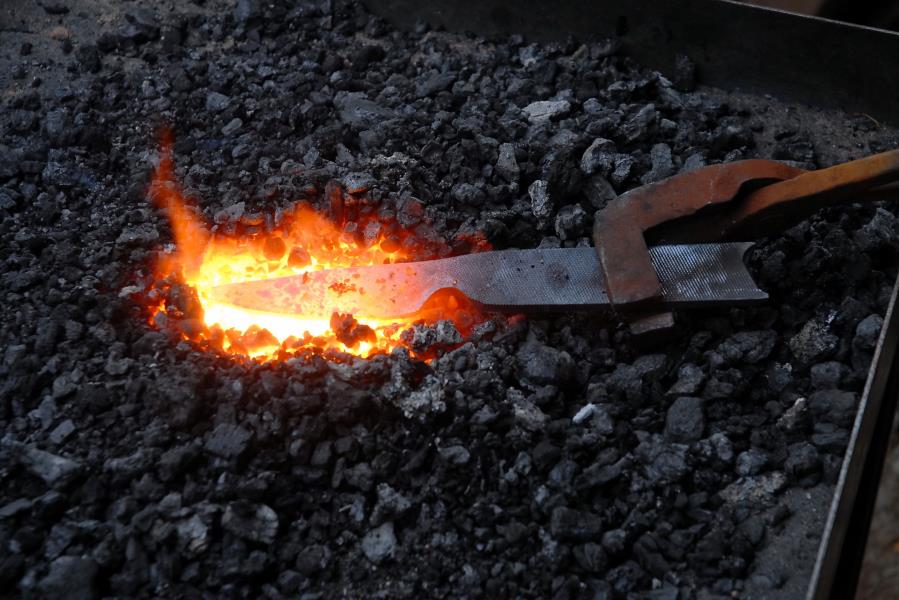
Carbon steel
All steel contains carbon as the primary alloying element to increase the metal’s hardness. Whether stainless or Damascus steel, which we’ll get to in a bit, they all have carbon to boost hardness and hardenability. It turns the weak iron into a strong material we call steel.
Carbon steel is the most basic form of steel. It has carbon along with other alloying elements to enhance its properties. However, they usually lack chromium or are only found in small quantities.
Therefore, they don’t have the corrosion-resistant properties of stainless steel. This is what separates carbon steel from stainless steel for the most part.
In most carbon steel, you’ll find a hard blade that maintains a sharp edge. While this is a favorable trait, carbon steel doesn’t have the best strength. Under aggressive use, it can chip due to increased brittleness. The carbon amount in the steel and its hardness are the biggest determiners of its toughness.
Pros of carbon steel
- It gives the blade a sturdy cutting edge that’s incredibly sharp.
- Generally easy to sharpen.
- It’s more affordable.
- There are various carbon steels to choose from, so you never run out of options.
Cons of carbon steel
- Can make a brittle blade that chips following robust use.
- Requires upkeep from the user to prevent rusting.
Stainless steel
The most popular steel choice for kitchen knives, stainless steel makes the best blade for home cooks. They produce a convenient knife that doesn’t rust. However, not all stainless steel is equal. How resistant it is to oxidation depends on its proportion to the other alloying elements.
Stainless steel is forgiving for incorrect use. The chromium makes it corrosion-resistant, and it also increases toughness. Chipping and other damages aren’t as prominent as carbon steel with stainless steel.
This steel type achieves these properties with a softer blade. However, they usually don’t keep a sharp edge for as long. In a way, there’s a trade between edge retention and corrosion resistance.
Considering how often average users pick up their knives, this group of customers will find stainless steel’s longevity of sharpness satisfying nonetheless.
Pros of stainless steel
- It ensures the blades won’t rust or oxidize.
- Stainless steel is generally tougher than the average carbon steel.
- It has fewer defects as a result of forging.
Cons of stainless steel
- It can’t hold a sharp edge for nearly as long.
- Sharpening stainless steel takes longer compared to carbon steel alternatives.
Damascus steel
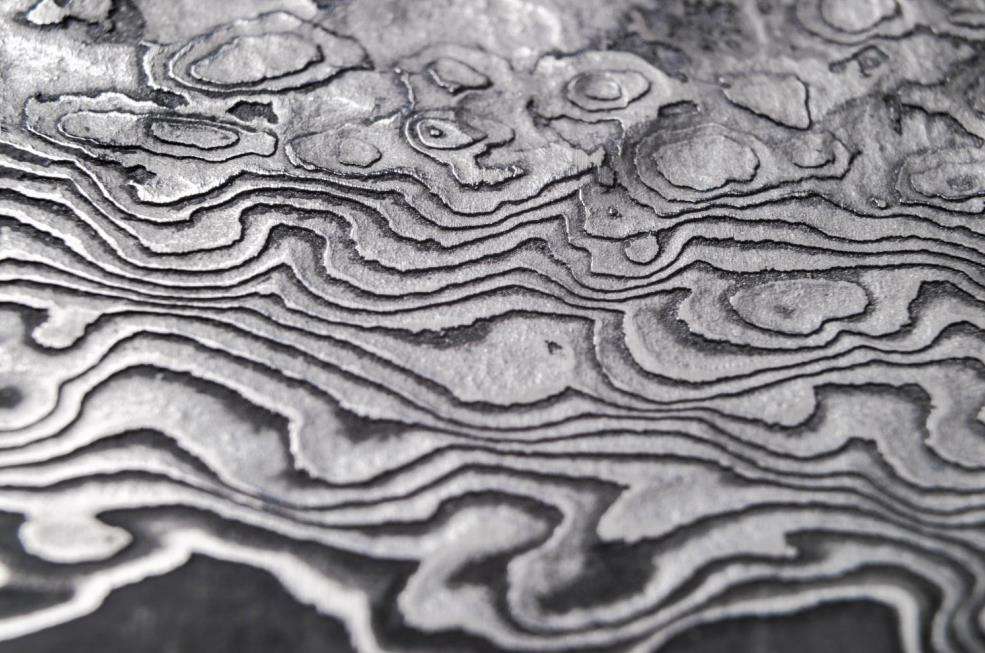
In the past, Damascus steel was made using wootz steel. The process of creating this unique material for Damascus steel is long lost.
Blacksmiths produce Damascus steel in today’s metallurgy by forge-welding various steel billets into one. The polished steel undergoes acid-etching to reveal the patterns. Due to the manufacturing process, Damascus steel is often called pattern-welded steel.
There aren’t specific properties of Damascus steel. Blacksmiths can use various steels, each adding to the final product’s traits.
Therefore, not all Damascus steel is equal. The beautiful patterns are what you’ll find the same in all Damascus steel. Still, they have diverse patterns, depending on the forge-welding methods.
Pros of Damascus steel
- It gives knives aesthetic, unique designs impossible to find in others.
- Damascus steel generally produces a high-quality knife with good sharpness, edge retention, and toughness.
Cons of Damascus steel
- The manufacturing process of Damascus steel is demanding, making it more expensive.
- Many imitated “Damascus steel” with patterns achieved by laser engraving exist. It’s vital to supply Damascus knives from a trusted supplier and know how to spot fake ones.
Buy Wholesale Knives and Start Scaling up with Us Today
Contact us and connect with a sales rep to get a free quote.
Powder steel
https://leeknives.com/powder-steel/Powder metallurgy is the pinnacle of metallurgy. These steels are made following the press and sinter process. This is simply bringing metal powders together with high heat and pressure.
The result is steel with a fine grain structure that’s uniform throughout. This process makes the produced steel strong with few defects.
It’s important to note that different steel companies have slightly different approaches. For example, Crucible has its patented way of creating powder steel under CPM, referring to Crucible Particle Metallurgy.
The fine grain size of powder metallurgy steel provides blades with a razor-sharp edge. Most powder steel is stainless. They have the same corrosion resistance abilities as regular stainless steel but slightly less. However, the finer carbides make powder steel have better durability.
Overall, powder steel produces a sharp blade that holds a better edge than stainless steel while also being resistant to rust to a slightly lesser degree.
Pros of powder steel
- The fine carbide size achieves a scary, sharp edge.
- It resists chipping better than regular steel.
- Powder steel is effortless to sharpen using standard whetstones.
Cons of powder steel
- It doesn’t resist corrosion as well as standard stainless steel.
- Powder steel is expensive to produce, which reflects in the products.
Powder steel vs. regular ingot steel
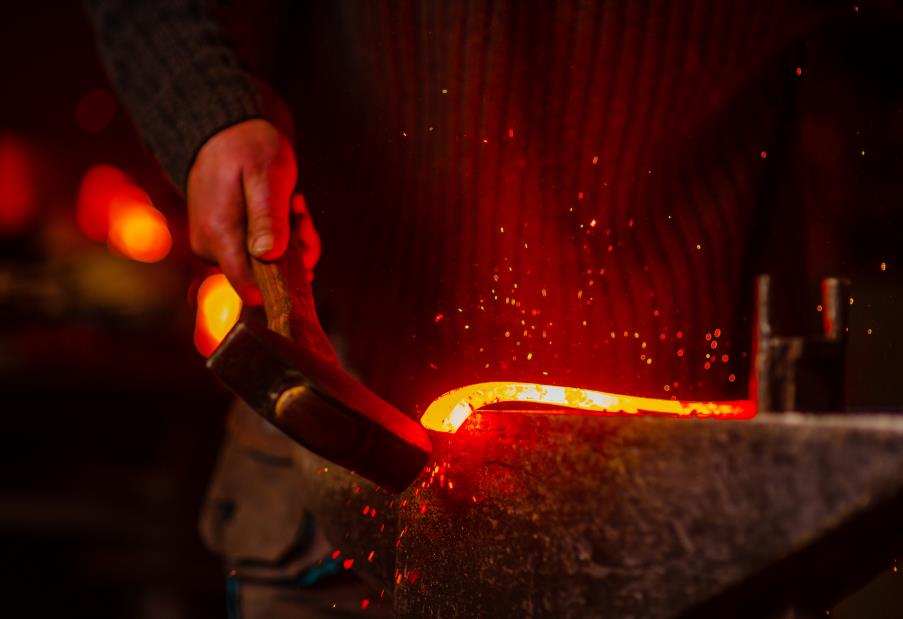
In short, the difference between powder metallurgy and regular ingot steel is in the manufacturing process. Powder metallurgy steels are more difficult to produce, making them more expensive.
The finer grain size of powder metallurgy steel gives them better toughness, wear resistance, and grindability for easier sharpening. They also respond to heat treatment consistently throughout the entire steel. This makes powder steels have very few defects when forging a blade.
Popular kitchen knife steels
Here comes the part we go over the popular steel names you’ll hear in kitchen knives. We’ll give brief but critical information about each steel to give you a sense of what to expect. Find them in alphabetical order below.
1.4116
1.4116 is German stainless steel with corrosion resistance and toughness are its main strengths. It has an adequate edge holding capability for home cooks and average users.
1.4116 steel won’t oxidize in unfavorable conditions that can easily rust carbon steel. 1.4116 makes a durable kitchen knife suitable for robust use. Cutting dense and frozen foods isn’t challenging for blades forged from it.
These make 1.4116 steel kitchen knives ideal for home use. However, businesses catering to professional chefs and serious cooks should look for alternatives. 1.4116 steel’s edge retention isn’t on par with premium-grade steel, but it takes regular honing good, prolonging the knife’s sharpness.
Learn more about 1.4116 steel:
1055
1055 is high carbon steel that withstands regular use. It has reliable wear resistance with reasonable toughness. The composition of 1055 steel is straightforward, with 0.60% carbon and up to 0.90% manganese.
1055 carbon steel isn’t brittle and holds a sharp edge but can’t resist rusting. The same as other carbon steel knives, it will develop a patina with use. Patina is the gray-colored layer that shields the blade from further oxidation.
While these make 1055 steel a good choice for kitchen cutlery, it’s more fitting for pocket knives. Nonetheless, it can make a solid knife to get vigorous use in the kitchen, like cleavers. A chef’s knife or slicing knife made from 1055 can leave the user with a rusted blade.
Learn more about 1055 steel:
1095
1095 is high carbon steel popular among custom knifemakers. It’s easy to heat treat, widely available, and affordable.
1095 can’t get a very refined edge that’s razor-sharp but has acceptable edge holding capabilities. Furthermore, it’s easy to sharpen. Bringing back the sharpness of a 1095 steel kitchen knife doesn’t take much time and effort. These help 1095 steel to have a prominent place in knife shops.
There are disadvantages to 1095 still. Proper heat treating is detrimental for it to remain durable and strong. If it isn’t heat treated correctly, the toughness won’t be beyond mediocre.
Learn more about 1095 steel:
10Cr15CoMoV
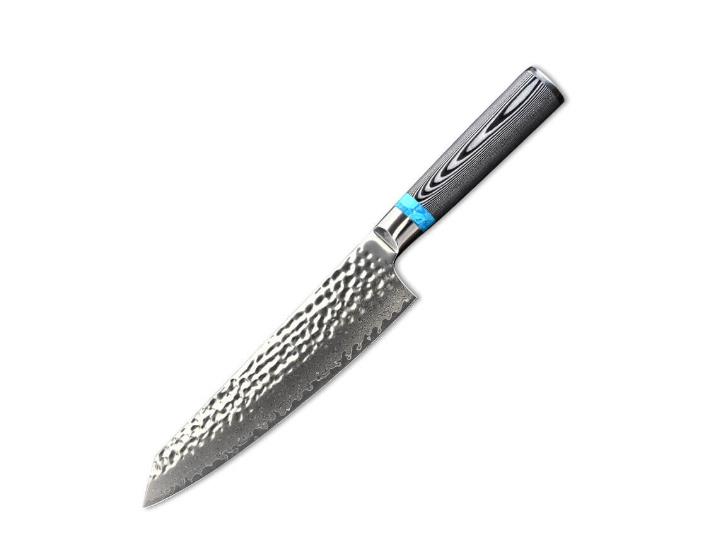
10Cr15CoMoV is equivalent to the Japanese VG-10, a popular steel choice we’ll also cover in this article.
10Cr15CoMoV has amazing sharpness that preserves it for extended durations. So much so that it can be too proficient for beginners. 10Cr15CoMoV knives better fit frequent users, serious cooks, and chefs.
Your customers will notice the surprising sharpness of 10Cr15CoMoV immediately. It will be even more unexpected once they realize how long it stays sharp over months of use.
Buy Wholesale Knives and Start Scaling up with Us Today
Contact us and connect with a sales rep to get a free quote.
Unlike many other steels, 10Cr15CoMoV doesn’t surrender much from its other properties. It’s durable and takes heavy-duty work lightly. Your wholesale orders of Japanese kitchen knives will cost you less with this steel without sacrificing anything from quality.
Learn more about 10Cr15coMoV steel:
14C28N
14C28N knife steel is popular for its wide hardness range. It can be as soft as 55 or 61 HRc hard. When differently heat treated to change hardness, its brittleness doesn’t change much. This is a helpful trait for forging various types of kitchen knives.
Sandvik, a Swedish engineering company, known for the 13C26 knife steel, produces 14c28n. It first came into existence after Kershaw Knives requested similar steel from the company with better corrosion resistance.
In this knife steel, your customers will get good edge retention and wear resistance with matching corrosion resistance abilities. 14C28N knife steel is most appropriate for multi-purpose kitchen knives and pocket knives.
Learn more about 14C28N steel:
154CM
154CM stainless steel is a standard blade material for many knife brands. It can bring good qualities to kitchen knives, but its toughness raises questions about its durability.
Under heavy workloads, 154CM knives can easily chip. When cutting dense ingredients or heavy chopping, this problem becomes more imminent.
Due to the doubts about its toughness, 154CM steel is more popular with pocket knives than kitchen knives. Spyderco, Benchmade, Civivi, and many other notable tactical knife manufacturers have a collection of 154CM knives.
Nevertheless, there is a good number of 154CM kitchen knives, mainly for delicate cutting tasks, for example, slicing knives. As long as the blade doesn’t get vigorous use, it will cut without damage. 154CM knives sustain a sharp cutting edge with just as good rust resistance.
Learn more about 154CM steel:
3Cr13
Corrosion resistance and toughness are the main highlights of this steel.
3Cr13 steel doesn’t have much carbon or other alloying elements adding to hardness. Most 3Cr13 knives are between 53 and 55 HRc. This is too soft for expecting good edge retention, but with low wear resistance, it offers quick sharpening.
Although many see 3Cr13 as low-end steel, it’s appropriate for knife shops selling to beginners. 3Cr13 is a durable material that won’t rust. 3Cr13 steel knives are very forgiving to incorrect use, making them ideal for beginner chefs and home cooks.
If edge retention and wear resistance aren’t the focal points of a knife, 3Cr13 is a good choice for your store.
Learn more about 3cr13 steel:
420
Knifemakers have been using 420 steel for decades to forge all types of blades. It’s relatively soft and doesn’t match the modern-day knife steel.
There aren’t many knives made using 420 steel anymore. Countless other alternatives give knife blades better traits. Still, if you find a manufacturer using 420 steel, you can drive a good bargain for your customers.
420 steel is more for budget knives with mediocre edge retention and wear resistance. It resists rusting and is fairly tough for many applications in the knife industry.
Learn more about 420 steel:
440A
440A is a typical stainless steel with adequate sharpness and edge retention. It has a high chromium amount with a touch of nickel that increases toughness.
The best ability of the kitchen knives made from this steel is corrosion resistance. 440A steel kitchen knives are dependable picks for users that don’t want to worry about rusting but ask for proper edge retention at an affordable price.
It’s decently tough but can have challenges withstanding continuous robust use. The nickel in the composition boosts its toughness but not to a level to make it very durable.
Learn more about 440A steel:
440C
440C steel can be an upgrade from 440A and 440B, depending on the characteristics you want to see in the knives you sell. It’s the hardest steel in the 440 series, with 1.10% carbon. This helps 440C achieve up to 57 HRc hardness.
440C steel knives are very common in the market, especially tactical knives. Nevertheless, many knife brands have 440C kitchen knives in various styles. You can sell 440C knives that are pleasing, from chef to vegetable knives.
It has proper edge retention and sharpness, but as with similar steel, the edge can turn toothy. 440C can’t hold a refined cutting edge for long periods due to its toughness. Its edge-holding capability comes at the expense of toughness, leading to a toothier edge over time. When this happens, a 440C steel knife still cuts but not as smooth as it once was.
Learn more about 440C Steel:
5Cr15MoV
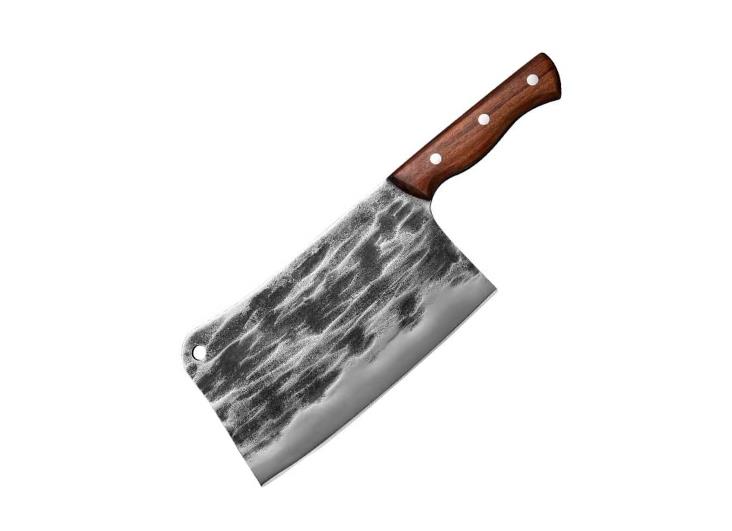
5Cr15MoV is Chinese knife steel equivalent to the 1.4116 and X50CrMoV15. All three have the exact qualities you’ll find in knife blades.
The most notable difference between 5Cr15MoV and the German-made alternatives is the price. 5Cr15MoV steel knives will run your customers significantly less. In quality, there won’t be any noticeable differences even after years of use.
5Cr15MoV delivers a highly rust-resistant kitchen knife that withstands robust use. 5Cr15MoV gets very sharp but can’t sustain it for as long. Regardless, 5Cr15MoV can fulfill the needs of at-home-cooks at an affordable price. Chefs and serious cooks are likely to ask for a more edge-sustaining blade.
Learn more about 5Cr15MoV steel:
65Mn
Durability is the highlight of 65Mn high carbon steel. It builds a sturdy kitchen knife that absorbs impacts without chipping or other damage.
65Mn steel owes this to the sufficient amounts of alloying elements decreasing its brittleness, namely silicon and manganese. Most kitchen knives made from 65Mn are ideal for heavy-duty work, like chopping bones.
The sharpness of 65Mn is fair but keeps it for extended periods. These make 65Mn an advantageous knife material, with its leading downside being the lack of corrosion-resistant abilities. Like other carbon steel knives, looking after 65Mn steel blades is essential to prevent decay.
Learn more about 65Mn steel:
7Cr17MoV
7Cr17MoV is Chinese knife steel suitable for forging blades for kitchen use. It has similar qualities to 440C with better toughness, which makes it all-rounder steel.
The strongest trait of 7Cr17MoV is rust resistance. The toughness is sufficient for all cutting needs in the kitchen. A variety of kitchen knives are produced using 7Cr17MoV. If your customers are from different backgrounds with various demands, 7Cr17MoV is versatile enough to fulfill their needs.
You can consider this knife steel as an alternative to 440C. It makes pleasant products that fill the gap between tough and highly corrosion-resistant products.
Learn more about 7Cr17MoV steel:
8Cr13MoV
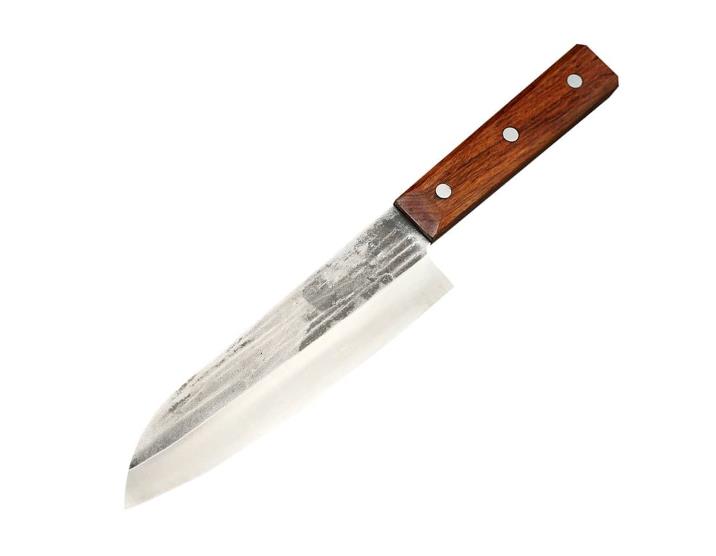
8Cr13MoV is in the same series as the 7Cr17MoV, with similar amounts of carbon but also a touch of vanadium.
This promotes the formation of hard vanadium carbides that contribute to wear resistance. However, it’s in small amounts, accounting for 0.25% of the steel’s composition, that doesn’t make it challenging to sharpen.
Ultimately, the wear resistance enables 8Cr13MoV knives to have better edge retention. The edge retention capability of 8Cr13MoV is comparable to 440C, but it’s much tougher. This knife steel makes a kitchen knife that cuts for long periods. It’s also durable enough to absorb impacts from aggressive cutting.
Buy Wholesale Knives and Start Scaling up with Us Today
Contact us and connect with a sales rep to get a free quote.
The increased toughness with satisfying edge retention made 8Cr13MoV dominate kitchen cutlery. The demanding use of Cai Dao, Kiritsuke, Gyuto, Santoku, Western-style chef’s knife, and many others is suitable for 8Cr13MoV.
Knife stores can offer budget-friendly yet delightful knives with 8Cr13MoV products, ensuring satisfaction to various customers.
Learn more about 8Cr13MoV steel:
9Cr18MoV
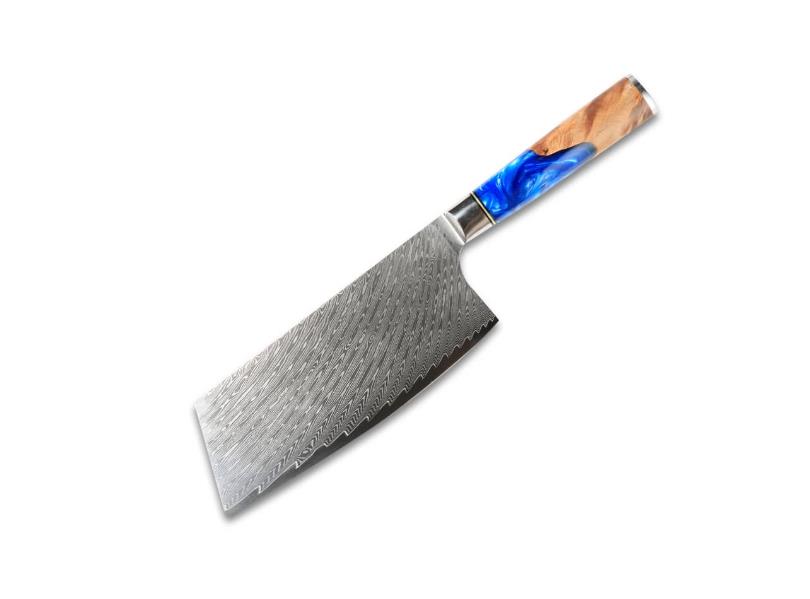
9Cr18MoV knife steel has more carbon and chromium than 7Cr17MoV and 8Cr13MoV. This helps 9Cr18MoV achieve a higher hardness, adding to edge retention and wear resistance.
9Cr18MoV also has a bit of vanadium at 0.12%, making it more wear-resistant. The knives made from this steel rate between 58 and 60 HRc per the Rockwell hardness scale.
While these give positive thoughts about its edge retention, the toughness of 9Cr18MoV isn’t the best. It has low-impact resistance that can get damaged under robust use.
9Cr18MoV is still a good choice for all-purpose kitchen knives, but your customers might complain about chips if used heavily. These move the use of 9Cr18MoV towards specialty knives that uphold slicing and delicate cutting duties, like Yanagiba.
Learn more about 9Cr18MoV steel:
ATS-34
ATS-34 is the equivalent of 154CM steel. You can think of ATS-34 as the Japanese version of 154CM. It’s stainless with solid wear resistance. The substantial resistance to wear and tear improves the edge retention of knives.
ATS-34 steel’s hardness is between 60 and 61 HRc. The property of this steel that stands out is wear resistance. The knives keep their smooth surface for long and won’t require polishing. However, sharpening it to a razor-sharp edge is difficult due to high wear resistance.
Lastly, ATS-34 is classified as stainless. Yet, it can rust if your customers neglect the blade continuously. Small dot-like rusty parts appearing on the knife is typical with ATS-34 knives. Remind your customers to clean and dry the blade after use and avoid leaving them dirty in the sink if you’re planning to sell ATS-34 or 154CM kitchen knives.
Learn more about ATS 34 Steel:
AUS-8
AUS-8 is mid-range Japanese knife steel. It has balanced properties compared to AUS-10, another steel in the same series with more carbon.
AUS-8 steel is tough enough to endure powerful strikes when cutting dense ingredients. It’s corrosion resistant with pleasing edge retention and wear resistance.
Your customers will have adequate edge retention, toughness, corrosion resistance, and sharpening ease with AUS-8 products. It’s a suitable pick for knife stores that want to sell kitchen knives with balanced features.
AUS-8 is perfect for all-purpose kitchen knives, like chef’s knives, Gyuto, and Santoku for home cooks.
Learn more about AUS 8 steel:
D2
D2 steel is air-hardening steel with fair corrosion resistance capabilities. Knifemakers heat treat D2 steel at under 2,000ºF and leave it at room temperature to harden. The ease of forging blades with D2 makes custom knifemakers favor it.
D2 steel isn’t entirely stainless but doesn’t rust all that easily. Despite the sufficient chromium amounts (16%), most of it is tied up in the carbides due to high carbon. For this reason, it’s semi-stainless. With D2 steel knives, your customers will get a blade that maintains a sharp cutting edge.
Learn more about D2 steel:
S30V
Crucible, an American steel company, manufactures S30V. It’s powder stainless steel with balanced properties that were designed to make knives.
S30V, also called CPM S30V, can reach up to 61 HRc on the Rockwell hardness scale. This hardness is enough to hint to us about its edge-holding capabilities. It gives blades a razor-sharp cutting edge that cuts for long, is wear-resistant, and tough enough to endure different cutting tasks.
S30V has uses in all kinds of knives, including kitchen knives. It’s suitable for producing chef’s, slicing, paring knives – you name it. Avoiding S30V when looking for knife steel with even traits across is next to impossible.
Learn more about S30V steel:
S90V
S90V is high-end stainless steel, also produced by Crucible, with impressive qualities. It’s commonly used for kitchen knives that get professional use. S90V is one of the few options with a good hardness that contributes to edge retention but is tough at the same level.
S90V steel’s optimal hardness for knives is between 57 and 60 HRc. Although this isn’t surprisingly high, the high vanadium in the composition enables S90V to hold a superb cutting edge. The knives made from this steel can make even frequent users forget about the existence of their whetstones.
While these make S90V one of the best stainless steels for forging knives, it comes with a price. S90V knives are significantly more expensive than many other knife steel mentioned in this article. However, considering this steel is for experts, many will find it worth the high price.
Learn more about S90V steel:
SG2
SG2, also known as Super Gold 2 or RS2, is Japanese powder steel. It’s the Japanese knife steel for professional chefs, favored for its ability to not lose sharpness in fast-paced kitchens.
SG2 is up to 64 HRc hard, rust-resistant, and durable enough for all-purpose use. Given its hardness and powder metallurgy, SG2 steel makes a dangerously sharp kitchen knife.
You can find many kitchen knives made from SG2, but they are costly. While SG2 steel kitchen knives are expensive, it’s not much compared to Shirogami and Aogami.
Learn more about SG2 steel:
Shirogami and Aogami
Shirogami and Aogami are also known as white and blue paper steel. As Japanese steel, Shirogami and Aogami get their names from the color of the paper the steel is wrapped in. These steels are primarily for forging high-end Japanese kitchen knives.
Shirogami is the modern-day equivalent of the traditional tamahagane steel. It’s carbon steel with excellent sharpness, great edge retention, and easy sharpening. This steel is solely for the Japanese kitchen knives master chefs use, like Yanagiba and Kiritsuke.
Aogami is similar to Shirogami, with only tiny differences setting them apart. Aogami has chromium (0.50%) and tungsten (2.50%) in composition that Shirogami doesn’t. This small difference allows Aogami to have better edge retention but sacrifices sharpness.
Learn more about Shirogami & Aogami:
VG-10
The Japanese VG-10 is widespread in Japanese kitchen knives. The traits it adds to blades are suitable for both home and professional kitchens.
VG-10 keeps a sharp cutting edge for adequate periods with its high hardness at 60 to 61 HRc. Many knife steel around this hardness tends to be quite brittle – not VG-10. It’s surprisingly tough, making it adaptable for various cutting duties.
Buy Wholesale Knives and Start Scaling up with Us Today
Contact us and connect with a sales rep to get a free quote.
The advantages of VG-10 knives don’t end there. They resist corrosion and are easier to sharpen. A couple of minutes on the whetstone is enough for your customers to restore the sharpness of their blades. VG-10 makes an outstanding kitchen knife but it’s pricey and not easy to obtain.
Learn more about VG 10 steel:
W2
W2 carbon steel is popular with custom knifemakers. It’s easy to heat treat, not requiring quenching oil as it’s water-hardening steel. This attribute makes W2 steel inexpensive to heat treat.
W2 steel can produce a decent and affordable kitchen knife if your customers look for a blade that stays sharp. W2 steel knives remain ready longer than even premium-grade stainless steel.
While it has edge retention beyond many stainless steels, it can rust. W2 steel has 0.15% chromium in its composition, contributing only to toughness and hardenability. Buyers of W2 steel knives must utilize the correct carbon steel care techniques.
Learn more about W2 steel:
X50CrMoV15
X50CrMoV15 is popular German knife steel found in countless knife brands’ products. Wusthof, Zwilling, Tefal, Solingen, and many other European brands have knives made from X50CrMoV15 steel.
The highlights of X50CrMoV15 are rust resistance and toughness. It delivers a very tough blade, perfect for multi-purpose use that won’t rust. X50XrMoV15 gets very sharp but doesn’t hold it for long. Using a honing rod to align the rugged cutting edge in between meals is recommended for maintaining its sharpness.
X50CrMoV15 is identical to 1.4116 steel. The difference is in the naming, not the actual properties of the steel. The manufacturers use the DIN system for naming X50CrMoV15, whereas 1.4116’s manufacturers brand it following the W-Nr system.
Learn more about X50CrMoV15 steel:
ZDP-189
ZDP-189 is another PM steel. This Japanese knife steel has high hardness – up to 65 HRc – and wear resistance, giving blades amazing edge retention.
ZDP-189 steel has about 20% chromium, but the high amounts of carbon overpower it during carbide formation, making it more susceptible to rusting.
With its hardness, you can expect a fragile blade that doesn’t take aggressive cutting lightly. ZDP-189 steel knives can chip unexpectedly, leaving your customers with a broken knife. They are also challenging to sharpen, but the edge retention makes up for it.
This knife steel is suitable for Japanese kitchen knives upholding slicing duties. You can find ZDP-189 steel commonly in Kiritsuke, Usuba, and Yanagiba.
Learn more about ZDP-189 steel:
What to look for when choosing steel for kitchen knives?
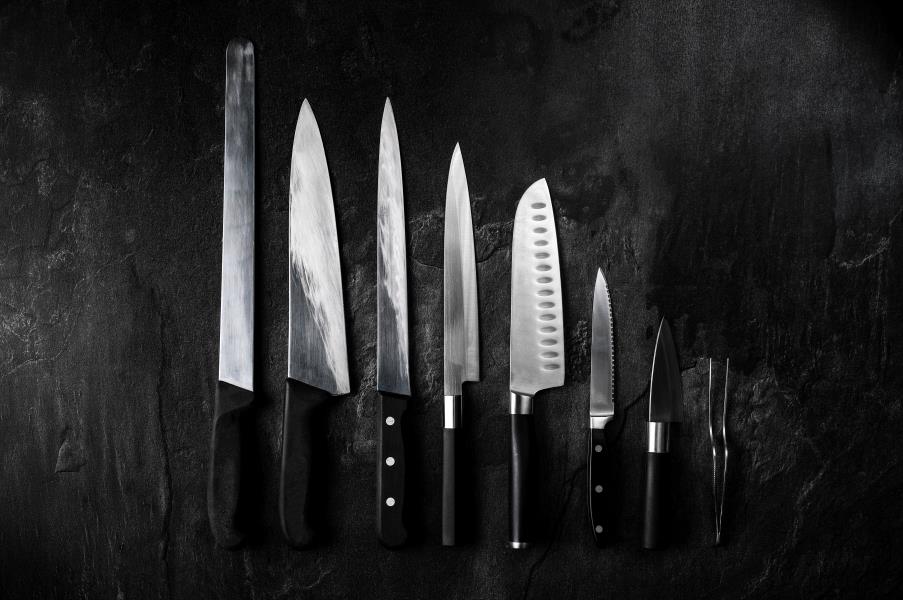
Hardness
The hardness can help shape an idea about what to expect from steel. The Rockwell hardness scale is the industry standard for measuring steel’s hardness. The following list can help you understand the features of steel at different hardness.
- 50 to 54 HRc: Knife steel in this hardness range usually has good toughness and corrosion resistance if it’s stainless. The edge retention is only mediocre. They can’t sustain a sharp edge for long durations.
- 55 to 58 HRc: Steel in this scope has balanced properties and usually doesn’t excel in a particular one. It mostly comes down to the chemical composition that determines their characteristics. 440C and S90V are good examples. The hardness is similar, but S90V holds a sharp edge for significantly longer thanks to the high vanadium.
- 58 and above: Knife steel with 58 HRc and above is hard but can be brittle also. Many steel names mentioned in this article surpass this threshold. 9Cr18MoV, ATS-34, VG-10, and ZDP-189 knives have hardness above 58 HRc. Heat treatment is vital for reducing brittleness. Otherwise, it will come at the expense of durability, leading to a blade that can hold an edge but is flimsy.
Buy Wholesale Knives and Start Scaling up with Us Today
Contact us and connect with a sales rep to get a free quote.
Toughness and durability
The toughness refers to the steel’s ability to absorb impact without permanent damage. Essentially, toughness translates to the durability of steel. Steel with high hardness tends to be brittle, therefore, low impact resistant.
While most steel with low hardness is pretty durable, it depends on heat treatment. The tempering process during heat treatment is vital to reduce brittleness. However, this isn’t to say any soft steel is more durable than harder alternatives. It depends on the alloying elements and their share in the composition.
Edge retention and wear resistance
Edge retention and wear resistance are directly impacted by hardness. The alloying elements that increase hardness also tend to help with wear resistance.
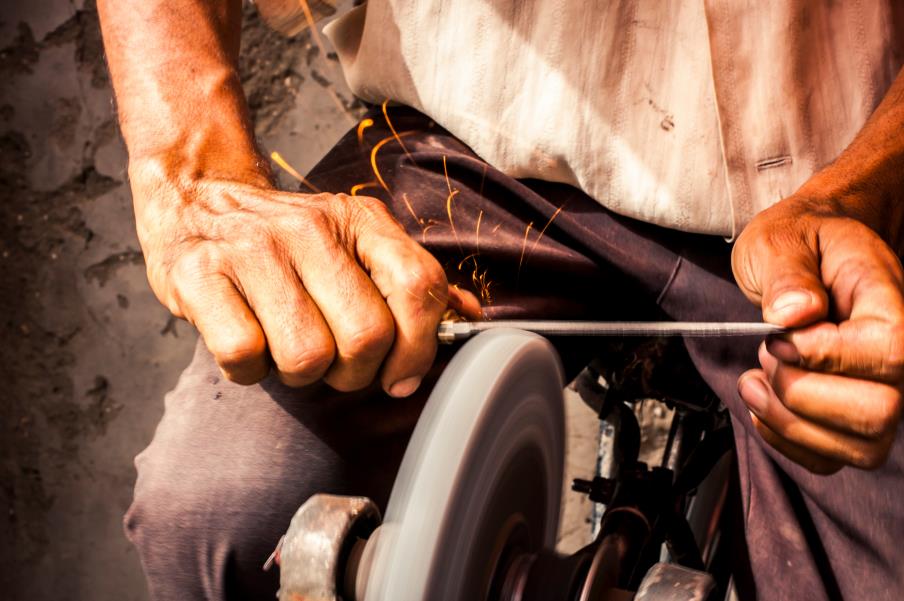
An increase in wear resistance improves edge retention but can make sharpening a nightmare. Luckily, a knife with low edge retention and wear resistance usually has easy sharpening and vice versa.
Average users don’t need anything exceptional as they won’t pick up their knives as much as professionals. A week of use for home cooks can easily be a standard shift for professional chefs. So, they demand something much more sustainable.
While edge retention is critical, having it at the forefront can reduce other properties, such as corrosion resistance and toughness. These are more important for home cooks than professionals. A blade that cuts usually without rusting or chipping makes a better product for average users.
Corrosion resistance
If the steel is too hard, it likely has a considerable amount of carbon. While this is a must-have for producing hard steel, increasing chromium at the same time doesn’t always lead to corrosion-resistant steel.
Take ZDP-189 as an example. It has 20% chromium, higher than many highly rust-resistant steel.
However, it also has a high amount of carbon at 3%. During the carbide formation, the carbon in the solution overpowers the chromium carbides from forming. The chromium tied in the carbides doesn’t help with corrosion resistance, making it more susceptible to rusting.
Having said that, the chromium to carbon ratio matters for stainless steel. You can take X50CrMoV15 and 3Cr13 as good examples. They don’t have much carbon but an abundance of chromium that achieves excellent corrosion resistance.
Learn basic steel properties based on its chemical composition
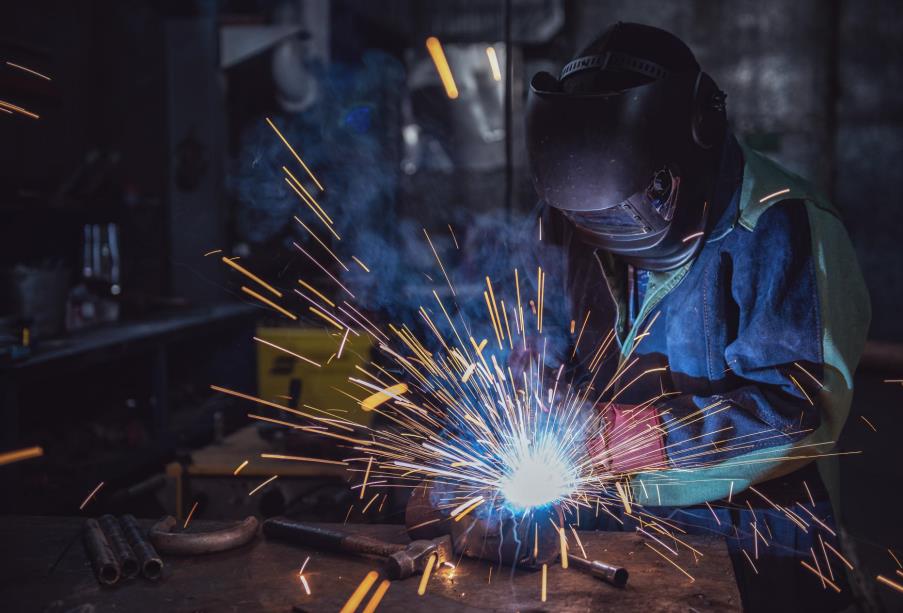
The space each alloying element takes up in steel is a clue to shape an idea about their properties. Here is what the common alloying elements do to steel at different amounts.
- Carbon (C): The most important alloy in steel, carbon increases hardness and improves hardenability. Yet, it can raise brittleness in high amounts, turning the steel into a fragile material prone to chip, crack, and shatter.
- Chromium (Cr): A must for stainless steel, chromium makes the steel corrosion-resistant. In low amounts, it can help with toughness.
- Vanadium (V): A standard alloying element for wear resistance, vanadium carbides are among the hardest. It makes the steel wear-resistant, contributing to edge retention greatly, but it can also make sharpening difficult.
- Manganese (Mn): Usually found in amounts not exceeding 1%, manganese increases durability by reducing brittleness. It also removes sulfur and oxygen during the conversion of iron ore to iron.
- Molybdenum (Mo): Quenching (cooling the steel rapidly) is what hardens steel. Molybdenum reduces the temperatures required for this heat treatment process. As a result, it improves hardenability while helping with corrosion resistance and tensile strength.
- Silicon (Si): When extracting iron from iron ore, many impurities occur, and silicon reduces them by a large margin. It also boosts hardness and toughness but not as much as manganese.
Now that you know what the common alloying elements do, examining the steel’s composition should give you a sense of the expected properties. You can find the composition of different knife steels from their manufacturer’s website. Optionally, check our knife steel category for an easier find.
Which steel kitchen knives should you sell?
Knife stores catering to home cooks and average users can choose 1.4116, X50CrMoV15, 3Cr13, 1095, 65Mn, 440A, and similar others mentioned in this article. These knife steels are durable and stainless or won’t rust with minimum upkeep. They keep a fine edge that satisfies daily users.
Selling to more serious cooks, such as professional chefs and culinary schools? There are plenty of alternatives that make a better blade. S30V, S90V, 8Cr13MoV, 9Cr18MoV, 10Cr15CoMoV W2, and ZDP-189 are better fitting picks for professional use.
For Japanese kitchen knives, ATS-34 and AUS-8 are ideal for home and serious cooks getting more into culinary arts. SG2, Shirogami & Aogami, and VG-10 are excellent for professionals.
Regardless of your steel choice, LeeKnives can help you bring the perfect product you picture to life. We can forge or stamp the blades using the materials you asked for through our OEM service.
Check our knife catalog for an extensive list of products we sell wholesale, ranging from Japanese knives to Western knives to sets. Click here to request a quote to partner up with LeeKnives today.
